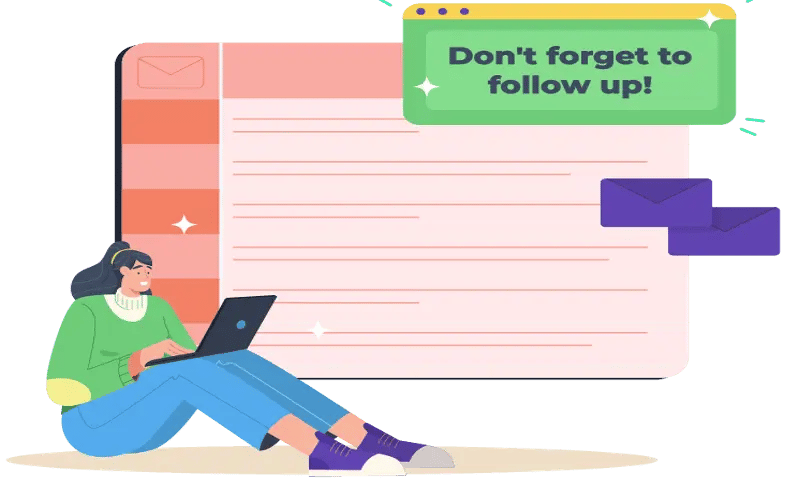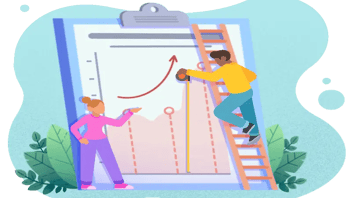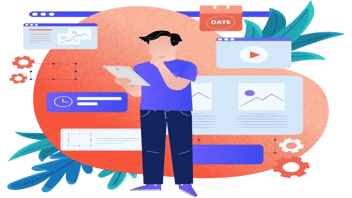网络研讨会是企业教育和吸引受众的有力工具,但网络研讨会之后会发生什么呢?跟进与会者对于建立关系并将他们转化为客户至关重要。虽然您在网络研讨会前进行了宣传,但如果不进行有效的后续跟进,就会将潜在的潜在客户留在台面上。
从制作有效的跟进电子邮件到利用滴灌活动培育潜在客户,我们将为跟进过程的每个阶段提供可行的建议。


只有42% 的营销人员会在 24 小时内跟进网络研讨会与会者。对网络研讨会与会者进行跟进是在竞争对手中脱颖而出的直接方法。
准备跟进
跟进网络研讨会与会者需要计划和准备,以确保在正确的时间将正确的信息传达给正确的人。您不能贸然向所有与会者群发邮件。相反,在网络研讨会后跟进与会者之前,请遵循以下步骤:
提前计划
准备跟进的第一步是计划。考虑网络研讨会营销的目标,以及您希望与会者在会后采取哪些行动。例如,如果您正在推广产品或服务,您的目标可能是将与会者转化为客户。或者,如果您利用网络研讨会来创造销售线索,那么您的目标可能是培养这些销售线索,并让他们进入销售漏斗。
一旦确定了目标,就要考虑使用哪种类型的跟进方式,如电子邮件、社交媒体或电话。每种方法都有其优缺点;您应该选择最适合您的目标和受众的方法。
细分受众
细分受众对于有针对性地开展后续活动至关重要。根据受众的兴趣、行为或人口统计学特征将他们划分为不同的群体,您就可以发送个性化的信息,更容易引起他们的共鸣。
细分受众的方法有很多,如按行业、职位或购买阶段。您还可以根据与会者参与网络研讨会的情况进行细分,例如他们是全程参加还是提前离开。通过细分受众,您可以根据他们的需求和兴趣定制后续信息,从而提高参与度和转化率。
现在,让我们深入了解如何跟进与会者。

利用滴灌式营销活动培育潜在客户
滴灌式营销活动是通过销售漏斗培养和提升潜在客户的有效方法。滴灌式营销活动是在一段时间内自动发送的一系列电子邮件,每封邮件都是为了在前一封邮件的基础上为收件人提供更多价值。
1.确定目标
创建滴灌营销活动的第一步是确定目标。您想通过该活动实现什么目标?您是想提高转化率、增加参与度,还是想为收件人提供更多信息?确定目标将有助于您创建符合自身需求的营销活动。
2.细分受众
细分受众对于有效开展滴灌式营销活动至关重要。您可以根据受众的行为或兴趣将他们划分为更小的群体,从而创建更具针对性和个性化的营销活动。例如,您可以根据受众在网络研讨会期间参加的会议或提出的问题对其进行细分。
3.绘制营销活动地图
一旦您确定了目标并细分了受众,就该规划您的营销活动了。决定要发送的电子邮件数量和间隔时间。每封邮件都应建立在前一封邮件的基础上,为收件人提供更多价值。
滴灌式营销活动的成功与否主要取决于内容的质量。利用从网络研讨会上获得的洞察力,创建高度相关、引人入胜的内容。混合使用教育内容、案例研究和促销优惠,让您的潜在客户保持参与并通过漏斗移动。
5.使用营销自动化工具
HubSpot 的营销自动化工具可以帮助你创建和管理滴灌式营销活动。通过这些工具,您可以自动执行电子邮件发送流程,跟踪营销活动的效果,并根据数据调整策略。HubSpot 的人工智能工具还能帮助您个性化内容并优化电子邮件,以提高参与度和转化率。
撰写有效的后续电子邮件
后续电子邮件是与网络研讨会与会者互动并推动他们完成销售漏斗的最有效方法之一(而且,由于使用了自动化和内容工具,通常也是最简单的方法)。那么,如何撰写有效的后续电子邮件呢?
1.从强有力的主题行开始
主题行是与会者收到电子邮件时首先会看到的内容,因此让它吸引注意力并具有相关性至关重要。使用简洁明了的主题行,突出信息的价值,鼓励与会者打开邮件。类似 "感谢您参加我们的网络研讨会--接下来是什么 "这样的主题行比 "网络研讨会后续行动 "这样的普通主题行更容易引起注意。
2.个性化信息
个性化是有效后续邮件的关键。你可以使用与会者的姓名和任何其他相关信息,例如他们在网络研讨会期间感兴趣的话题或提出的问题。您还可以使用 HubSpot 的人工智能内容创建工具,根据与会者的行为和兴趣自动生成个性化内容。
.
3.提供价值
如果后续邮件能提供价值,与会者就更有可能参与其中。您可以利用后续电子邮件提供与网络研讨会主题相关的其他资源,如白皮书、案例研究或博客文章。您还可以提供独家折扣或促销活动,激励与会者采取行动。提供网络研讨会的录制版本也很有帮助,这样与会者可以重新观看,以防错过任何内容。
4.包含明确的 CTA
明确的行动号召(CTA)对于促进转化至关重要。使用清晰、可操作的行动号召,鼓励与会者采取下一步行动,如安排演示或注册免费试用。在电子邮件中加入醒目的按钮或链接,方便与会者采取行动。
如果您还在为后续电子邮件的撰写而烦恼--不用担心。在为网络研讨会与会者撰写后续电子邮件时,使用HubSpot 的内容助手可以帮助您优化内容,以获得更好的效果。通过分析电子邮件内容,该工具可以推荐相关关键词,确保语法和拼写的正确使用,并提供可读性和语气分析。
此外,内容助手还能帮助确保电子邮件遵循电子邮件营销的最佳实践,如使用简洁明了的主题行、个性化问候语和引人注目的号召行动。

利用社交媒体进行跟进
社交媒体是与受众互动、培养与潜在客户关系的绝佳平台。下面介绍如何利用社交媒体跟进网络研讨会与会者:
1.分享网络研讨会录音
在社交媒体上分享网络研讨会录音是与与会者和可能错过活动的人互动的好方法。通过分享录音,您可以为受众提供价值,并鼓励他们与您的品牌互动。
2.突出主要收获
利用社交媒体突出网络研讨会的主要收获。分享引起与会者共鸣的引语、统计数据或见解,并提供更多的背景或评论。这将有助于保持话题的持续性,并鼓励与会者在社交媒体上与您的品牌互动。
3.回复评论和问题
您可以通过回复评论和问题与社交媒体上的与会者互动。这将有助于与受众建立关系,并表明您重视他们的意见和反馈。及时、有益的回复也有助于与受众建立信任和信誉。
4.分享其他资源
您可以利用社交媒体分享与网络研讨会相关的其他资源。这可能包括博客文章、白皮书或案例研究。通过向受众提供有价值的资源,您可以展示自己的专业知识,并树立自己作为行业思想领袖的品牌形象。
5.使用付费广告
考虑在社交媒体上投放付费广告,以覆盖更多受众并推广您的后续内容。您可以针对特定人群或兴趣投放广告,确保合适的人看到您的内容。
额外提示: HubSpot 的社交媒体管理工具可以帮助你管理社交媒体并跟踪广告活动的效果。您可以提前安排帖子,监控社交媒体活动,跟踪参与度和转换指标。
电话跟进
虽然电子邮件和社交媒体是跟进网络研讨会与会者的好工具,但有时电话也是培养潜在客户的最有效方式。不过,需要注意的是,很多人可能不会接受冷冰冰的电话。
如果你打算通过电话进行跟进,那么必须有一个明确的目标并准备好脚本。您还应确保您在适当的时间打电话,并且对方正在等待您的电话。这将有助于确保您的通话富有成效,不会让人觉得您是在打扰或不受欢迎。
考虑发送个性化视频信息或提前安排通话时间,以替代冷冰冰的电话。这有助于与潜在客户建立良好关系,增加他们接受你信息的机会。
跟踪和分析跟进结果
跟踪和分析跟进结果对于了解哪些有效哪些无效至关重要。您可以通过监控网络研讨会的关键指标(如打开率、点击率和转换率),做出以数据为导向的决策,以优化您的跟进策略。
跟踪跟进结果的一个有效方法是使用HubSpot 等 CRM(客户关系管理)系统。CRM 系统可帮助您跟踪联系人、细分受众并跟踪参与度和转化指标。这可以帮助您识别跟进数据的趋势和模式,并根据需要进行调整。
跟踪和分析跟进结果的另一个关键方面是设定成功的目标和基准。通过确定成功的网络研讨会活动对您的跟进策略意味着什么,并定期根据这些基准衡量您的进展情况,您可以确保您正在实现目标和目的的轨道上。
跟进与会者对于网络研讨会营销战略至关重要。通过准备后续行动、制作有效的电子邮件、通过滴水式营销活动培养潜在客户、利用社交媒体以及明智地使用电话,您可以与潜在客户建立稳固的关系,并将他们进一步推向销售漏斗。通过跟踪和分析跟进结果,您可以做出以数据为导向的决策,并随着时间的推移不断改进您的策略。













发表评论